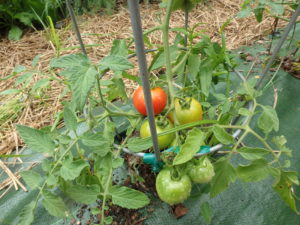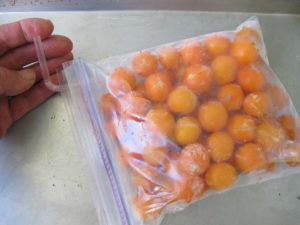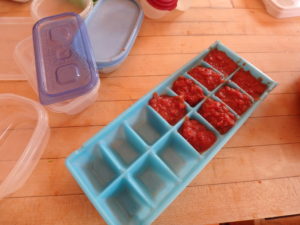Getting Ready for Winter
Here it is, early August and I’ve just picked my first tomatoes, but I’m already thinking about winter. No, I don’t anticipate frost until mid-October or later, but I depend on my garden to feed me much of the year. So I start early getting food processed for storage. I freeze, dehydrate, can and store veggies for winter. Let’s look at tricks you can use to save you time and labor as you save your harvest.
Tomatoes are key to almost any soup, stew or stir fry I make, and I don’t want to be buying tomatoes in February, or to depend on cans of sauce processed in factories in California. I want to cook with tomatoes that I grew myself, or that are from a local farmer I trust.
If you grow just a few tomato plants for sandwiches and salads, or even if you planted half a dozen ‘Romas’ for making some sauce, you can have a wealth of tomatoes for freezing if you talk to your local farmer. Most sell “field grade” or “canners” by the bushel at very reasonable prices. They are not as pretty as top grade fruits, but I’ve bought a bushel – 50 pounds –in years when my own crop succumbed early to blight.
Many farmers now grow tomatoes in hoop houses which means they get tomatoes earlier than we do, and they largely avoid blight. So there are times when farmers are practically swimming in tomatoes. That’s when to buy them.
What can you do with 50 pounds of tomatoes? I would freeze most of them. Wash and dry the fruit, then fit them into freezer-grade plastic bags, not storage bags. Freezer-grade bags cost just pennies more per bag, but are much better for the job.
Suck out any excess air from the bags with a common drinking straw. Just close the bag 99% of the way, suck out the air and snap it closed with 2 fingers – just as you pull out the straw.
Later, to get them ready for use, I run each frozen tomato under hot water while rubbing it gently so that the skin comes right off. After I set it aside for 5 minutes it softens enough for me to cut out the stem attachment point. Then I quarter it, chop it, and put it in the pan.
If you like to make homemade sauce but hate the canning process, just freeze it. Cook up your tomatoes with fresh herbs and onions, and let it cool. Then pack in freezer bags or plastic containers.
I’ve had both front-opening freezers and chest freezers, and I recommend the front-opening ones. It is easy to lose track of what is buried in the bottom of the chest-type freezers. But you’ll find the last bag of kale if it’s on a shelf where you can easily see it. And after a year or two in a freezer, food loses its flavor and often becomes unappealing.
I also freeze ice cube trays filled with my homemade tomato paste. I use my less-perfect tomatoes for paste, which I freeze in ice cube trays. To make paste, I wash tomatoes, and then core them with a paring knife. I squeeze out the seeds and extra juice, which makes for less boiling time and fewer seeds. Then I quarter them and puree them, skins and all, in my food processor.
I cook the puree at low heat in a big enameled cast iron pot (which helps prevent scorching on the bottom of the pot). I know it’s done when I can literally stand up a soupspoon in the paste – after 3 hours or more. I let it cool overnight (or 8 hours) with the cover off the pot, allowing a little more moisture to evaporate. Then I spoon the paste into the ice cubes trays. After they are frozen, I remove the cubes and put them in freezer bags.
Most years I dehydrate several bags of “sun-dried tomatoes”. Except they aren’t sun-dried. They are dried in an electric food dryer. Mostly I dry cherry tomatoes, a variety called ‘Sun Gold’. I cut them in half and place them face up on the screens. It takes from 12 to 24 hours to do a batch, depending on which kind of machine you use, and how juicy your tomatoes are.
I have 2 brands of dryers, a NESCO American Harvester and an Excalibur. The Excalibur uses less electricity (660 watts per hour vs. 1,000 watts per hour) and is more efficient because the flow of hot air goes across the drying screens, not from top to bottom as the NESCO dryer does. But it costs roughly 3 times as much, depending on the model. Both brands are very good.
I also use my dehydrators to dry apples, pears, hot peppers and more. I especially like drying hot peppers because I can get them brittle, and then grind them up in my coffee grinder. That allows me to just add a little in a dish – or a lot if I’m not having company.
So don’t wait until fall. Start putting up food for winter like the proverbial squirrel. Winter is just around the corner.
Henry is the author of 4 gardening books. His web site is www.Gardening-Guy.com. See extra photos for his newspaper articles at https://dailyuv.com/





